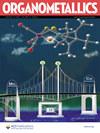Rh → Sb Interactions Supported by Tris(8-quinolyl)antimony Ligands
IF 2.9
3区 化学
Q2 CHEMISTRY, INORGANIC & NUCLEAR
引用次数: 0
Abstract
The ligands tris(8-quinolyl)stibine and tris(6-methyl-8-quinolyl)stibine have been synthesized and complexed to rhodium using (MeCN)3RhCl3. The resulting complexes feature an unusual [RhSb]VI core as a result of the formal insertion of the antimony center into one of the Rh–Cl bonds. Computational analysis using density functional theory (DFT) methods reveals that the resulting Rh–Sb σ bond is polarized toward the Rh atom, suggesting a description of this linkage as a Rh → Sb Z-type interaction.

三(8-喹啉基)锑配体支持的 Rh → Sb 相互作用
我们合成了配体三(8-喹啉基)锡丁和三(6-甲基-8-喹啉基)锡丁,并用 (MeCN)3RhCl3 与铑络合。由于锑中心正式插入到 Rh-Cl 键中的一个键中,因此生成的配合物具有不寻常的[RhSb]VI 核心。使用密度泛函理论 (DFT) 方法进行的计算分析表明,所产生的 Rh-Sb σ 键向 Rh 原子极化,这表明这种连接可以描述为 Rh → Sb Z 型相互作用。
本文章由计算机程序翻译,如有差异,请以英文原文为准。
求助全文
约1分钟内获得全文
求助全文
来源期刊

Organometallics
化学-无机化学与核化学
CiteScore
5.60
自引率
7.10%
发文量
382
审稿时长
1.7 months
期刊介绍:
Organometallics is the flagship journal of organometallic chemistry and records progress in one of the most active fields of science, bridging organic and inorganic chemistry. The journal publishes Articles, Communications, Reviews, and Tutorials (instructional overviews) that depict research on the synthesis, structure, bonding, chemical reactivity, and reaction mechanisms for a variety of applications, including catalyst design and catalytic processes; main-group, transition-metal, and lanthanide and actinide metal chemistry; synthetic aspects of polymer science and materials science; and bioorganometallic chemistry.
 求助内容:
求助内容: 应助结果提醒方式:
应助结果提醒方式:


